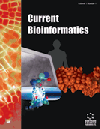- Home
- A-Z Publications
- Current Bioinformatics
- Previous Issues
- Volume 15, Issue 1, 2020
Current Bioinformatics - Volume 15, Issue 1, 2020
Volume 15, Issue 1, 2020
-
-
Computational Approaches for Transcriptome Assembly Based on Sequencing Technologies
More LessAuthors: Yuwen Luo, Xingyu Liao, Fang-Xiang Wu and Jianxin WangTranscriptome assembly plays a critical role in studying biological properties and examining the expression levels of genomes in specific cells. It is also the basis of many downstream analyses. With the increase of speed and the decrease in cost, massive sequencing data continues to accumulate. A large number of assembly strategies based on different computational methods and experiments have been developed. Read More
-
-
-
Analysis of Germin-like Protein Genes (OsGLPs) Family in Rice Using Various In silicoApproaches
More LessAuthors: Muhammad Ilyas, Muhammad Irfan, Tariq Mahmood, Hazrat Hussain, Latif-ur-Rehman, Ijaz Naeem and Khaliq-ur-RahmanBackground: Germin-like Proteins (GLPs) play an important role in various stresses. Rice contains 43 GLPs, among which many remain functionally unexplored. The computational analysis will provide significant insight into their function. Objective: To find various structural properties, functional importance, phylogeny and expression pattern of all OsGLPs using various bioinformatics tools. Methods: Physiochemical properties, sub Read More
-
-
-
ESDA: An Improved Approach to Accurately Identify Human snoRNAs for Precision Cancer Therapy
More LessAuthors: Yan-mei Dong, Jia-hao Bi, Qi-en He and Kai SongBackground: SnoRNAs (Small nucleolar RNAs) are small RNA molecules with approximately 60-300 nucleotides in sequence length. They have been proved to play important roles in cancer occurrence and progression. It is of great clinical importance to identify new snoRNAs as fast and accurately as possible. Objective: A novel algorithm, ESDA (Elastically Sparse Partial Least Squares Discriminant Analysis), was proposed Read More
-
-
-
Integration and Querying of Heterogeneous Omics Semantic Annotations for Biomedical and Biomolecular Knowledge Discovery
More LessAuthors: Omer Irshad and Muhammad U. G. KhanBackground: Exploring various functional aspects of a biological cell system has been a focused research trend for last many decades. Biologists, scientists and researchers are continuously striving for unveiling the mysteries of these functional aspects to improve the health standards of life. For getting such understanding, astronomically growing, heterogeneous and geographically dispersed omics data needs to be critically a Read More
-
-
-
MSIT: Malonylation Sites Identification Tree
More LessAuthors: Wenzheng Bao, De-Shuang Huang and Yue-Hui ChenAims: Post-Translational Modifications (PTMs), which include more than 450 types, can be regarded as the fundamental cellular regulation. Background: Recently, experiments demonstrated that the lysine malonylation modification is a significant process in several organisms and cells. Meanwhile, malonylation plays an important role in the regulation of protein subcellular localization, stability, translocation to lipid rafts a Read More
-
-
-
Predicting Drug-target Interactions via FM-DNN Learning
More LessAuthors: Jihong Wang, Hao Wang, Xiaodan Wang and Huiyou ChangBackground: Identifying Drug-Target Interactions (DTIs) is a major challenge for current drug discovery and drug repositioning. Compared to traditional experimental approaches, in silico methods are fast and inexpensive. With the increase in open-access experimental data, numerous computational methods have been applied to predict DTIs. Methods: In this study, we propose an end-to-end learning model of Factoriza Read More
-
-
-
The Expression Profiles of lncRNAs and Their Regulatory Network During Smek1/2 Knockout Mouse Neural Stem Cells Differentiation
More LessAuthors: Qichang Yang, Jing Wu, Jian Zhao, Tianyi Xu, Ping Han and Xiaofeng SongBackground: Previous studies indicated that the cell fate of neural stem cells (NSCs) after differentiation is determined by Smek1, one isoform of suppressor of Mek null (Smek). Smek deficiency prevents NSCs from differentiation, thus affects the development of nervous system. In recent years, lncRNAs have been found to participate in numerous developmental and biological pathways. However, the effects of knocking o Read More
-
Volumes & issues
-
Volume 20 (2025)
-
Volume 19 (2024)
-
Volume 18 (2023)
-
Volume 17 (2022)
-
Volume 16 (2021)
-
Volume 15 (2020)
-
Volume 14 (2019)
-
Volume 13 (2018)
-
Volume 12 (2017)
-
Volume 11 (2016)
-
Volume 10 (2015)
-
Volume 9 (2014)
-
Volume 8 (2013)
-
Volume 7 (2012)
-
Volume 6 (2011)
-
Volume 5 (2010)
-
Volume 4 (2009)
-
Volume 3 (2008)
-
Volume 2 (2007)
-
Volume 1 (2006)
Most Read This Month
Article
content/journals/cbio
Journal
10
5
false
en


